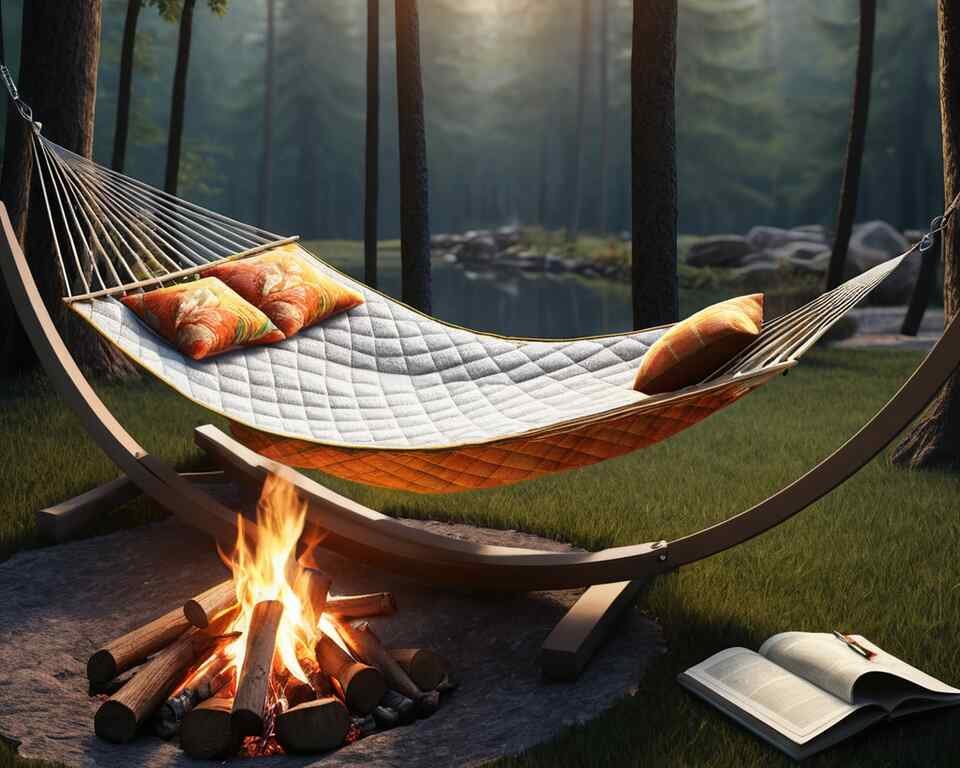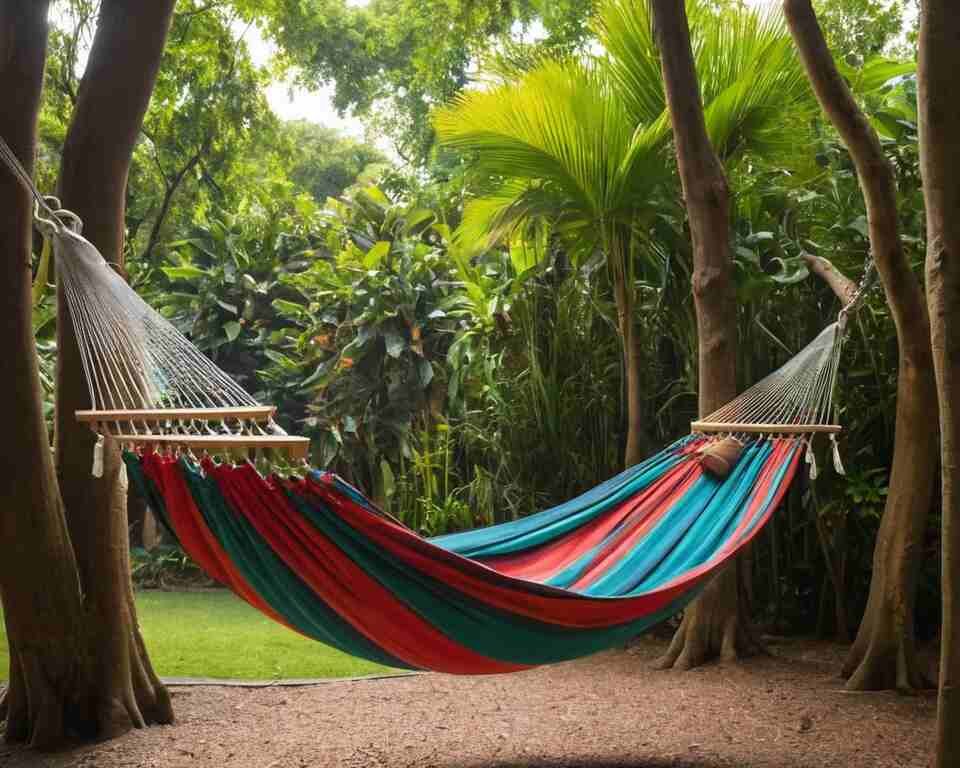Affiliate Disclosure: As an Amazon Associate, I earn from qualifying purchases. This means I may receive a commission if you buy through my links, at no extra cost to you.
Are you ready to embark on a journey through the world of suspended relaxation? Whether you’re an avid camper, a backyard enthusiast, or simply someone who appreciates the gentle sway of a hammock, understanding the various types of hammocks available can enhance your lounging experience.
At Karenzo Hammocks, we believe in helping you find the perfect hammock for your needs. In this comprehensive guide, we’ll explore the diverse world of hammocks, from traditional designs to modern innovations, ensuring you make an informed choice for your relaxation.
Click the Play button below to listen to our podcast:
The Evolution of Hammocks: From Necessity to Luxury
Ancient Origins and Cultural Significance
Hammocks have a rich history dating back over 1,000 years. Originally developed by indigenous peoples in Central and South America, these suspended beds were designed to provide protection from ground-dwelling insects and animals. The word “hammock” itself is derived from the Taíno word “hamaca,” highlighting its deep cultural roots.
Recent archaeological findings suggest that hammocks may have been used even earlier than previously thought. In 2018, researchers discovered preserved hammock fibers in a cave in Mexico, dating back approximately 9,000 years, potentially pushing the origin of hammocks back several millennia.
From Naval Use to Modern Leisure
As European explorers encountered hammocks during their voyages, they quickly recognized their practicality. Navies around the world adopted hammocks for their space-saving design and ability to provide comfortable sleep even in rough seas. Fast forward to today, and hammocks have evolved into popular leisure items, perfect for relaxation in various settings.
During the Golden Age of Sail (1571-1862), hammocks became standard issue on naval vessels. Interestingly, when a sailor died at sea, they were often buried in their hammock, which was weighted down to ensure it sank. This practice gave rise to the term “hammock” as naval slang for a sailor’s grave.

Types of Hammocks: A Comprehensive Overview
Let’s dive into the main types of hammocks available today. Each type has its unique characteristics, benefits, and ideal use cases.
1. Rope Hammocks
Rope hammocks are perhaps the most iconic and recognizable type. They’re characterized by their open, netted design made from cotton or synthetic ropes.
Pros:
- Excellent ventilation
- Classic aesthetic
- Durable construction
Cons:
- Can leave imprints on skin
- Not ideal for colder weather
- Require more maintenance
Best for: Backyard relaxation, warm climates
The spacing between ropes in a hammock is crucial for comfort and durability. Most high-quality rope hammocks use a “diamond weave” pattern with approximately 1-inch gaps, which provides optimal support while maintaining breathability.

2. Quilted Hammocks
Quilted hammocks offer a more luxurious lounging experience with their padded design and reversible fabric layers.
Pros:
- Very comfortable
- Suitable for cooler weather
- Often come with spreader bars for easier entry
Cons:
- Heavier than other types
- Can retain moisture
- Less suitable for camping
Best for: Home use, patios, decks
The padding in quilted hammocks often consists of polyester fiberfill, which provides insulation and comfort. However, some high-end models use natural materials like cotton or even wool for a more eco-friendly approach.

3. Nicaraguan Hammocks
Also known as Nicaragua-style hammocks, these are handwoven from soft cotton or nylon threads, creating a dense, comfortable surface without the need for spreader bars.
Pros:
- Extremely comfortable
- Compact when not in use
- Authentic cultural design
Cons:
- Can be less stable for beginners
- May stretch over time
- Require proper hanging technique
Best for: Indoor use, tropical settings, authentic decor
Traditional Nicaraguan hammocks are made using a technique called “punto de cruz” or cross-stitch. This method creates a distinctive diamond pattern that not only looks beautiful but also enhances the hammock’s strength and flexibility.

4. Brazilian Hammocks
Brazilian hammocks are similar to Nicaraguan hammocks but are typically made from tightly woven cotton fabric, creating a smooth, soft surface.
Pros:
- Very comfortable and enveloping
- Durable construction
- Available in vibrant colors and patterns
Cons:
- Can be warm in hot weather
- May require practice to enter and exit gracefully
- Less suitable for multiple occupants
Best for: Indoor and outdoor relaxation, tropical climates
In Brazil, hammocks are deeply ingrained in the culture, particularly in the northeastern region. Many homes in this area have built-in hammock hooks, and it’s not uncommon for people to prefer sleeping in hammocks over traditional beds.

5. Camping Hammocks
Designed for outdoor enthusiasts, camping hammocks are lightweight, compact, and often made from durable synthetic materials.
Pros:
- Extremely portable
- Quick and easy setup
- Often include built-in bug nets and rain flies
Cons:
- May be less comfortable for extended use
- Require trees or support structures
- Can be chilly without proper insulation
Best for: Backpacking, hiking, camping
Modern camping hammocks often use high-tech fabrics like ripstop nylon, which can support over 400 times its own weight. Some ultralight models weigh less than 7 ounces (200 grams) while still supporting up to 300 pounds (136 kg).

6. Spreader Bar Hammocks
Spreader Bar hammocks feature wooden or metal bars at each end to keep the hammock taut and flat.
Pros:
- Easy to enter and exit
- Provides a flatter lying surface
- Often more aesthetically pleasing in garden settings
Cons:
- Less stable than gathered-end hammocks
- More prone to flipping
- Take up more space when hung
Best for: Backyard relaxation, beginners
The concept of spreader bars was introduced in the mid-20th century by an American hammock manufacturer. While they make hammocks easier to use for beginners, they actually reduce the hammock’s natural ability to conform to the body, potentially making them less comfortable for extended use.

7. Chair Hammocks
Also known as hammock chairs or swing chairs, these provide a seated hammock experience.
Pros:
- Take up less space
- Easier to get in and out of
- Great for reading or working
Cons:
- Less lounging space
- Not ideal for sleeping
- May require a sturdy hanging point
Best for: Small spaces, patios, indoor use
Some innovative chair hammock designs incorporate ergonomic principles to provide lumbar support and promote good posture, making them an excellent option for those who suffer from back pain.

Comparing Hammock Types: A Handy Reference Table
To help you quickly compare the different types of hammocks, here’s a comprehensive table:
| Hammock Type | Material | Best Use | Comfort Level | Portability | Durability |
|---|---|---|---|---|---|
| Rope | Cotton or Synthetic | Backyard | Moderate | Low | High |
| Quilted | Fabric with Padding | Home/Patio | High | Low | Moderate |
| Nicaraguan | Cotton or Nylon | Indoor/Outdoor | Very High | Moderate | Moderate |
| Brazilian | Woven Cotton | Indoor/Outdoor | High | Moderate | High |
| Camping | Nylon or Polyester | Outdoor Adventures | Moderate | Very High | High |
| Spreader Bar | Various | Backyard | High | Low | Moderate |
| Chair | Various | Small Spaces | Moderate | Moderate | Moderate |
| Brazilian (specific) | Tightly Woven Cotton | Indoor/Dry Outdoor | Very High | Moderate | High |
| Camping (specific) | Lightweight Nylon/Polyester | Outdoor Use | Moderate | Very High | High |
| Mayan | Breathable String Design | Hot Environments | Very High | High | Moderate |
| Quilted (specific) | Padded Fabric | Cooler Weather | High | Low | Moderate |
| Rope (specific) | Cotton or Nylon | Casual Lounging | Moderate | Low | High |
| Poolside | Mildew-Resistant Material | Near Swimming Pools | Moderate | Moderate | High |
| Nicaraguan (specific) | Soft Cotton Cords | Indoor/Outdoor | Very High | Moderate | Moderate |
| American | Rope, Fabric, or Quilted | Backyard/Patio | High | Low | High |
| Mayan & Brazilian (Cocoon-Style) | Cotton or Nylon (Mayan), Woven Cotton (Brazilian) | Indoor/Outdoor | Very High | Moderate (Brazilian), High (Mayan) | High |
| Double | Cotton or Synthetic | Couples/Family | High | Moderate | Moderate |
| Travel | Nylon or Polyester | Backpacking/Hiking | Moderate | Very High | Moderate |
| Stand-Alone | Various | Backyard/Patios | High | Low | Moderate |
| Hammock Tent | Nylon or Polyester | Camping | High | Moderate | High |
| Net | Synthetic Mesh | Poolside/Outdoor Lounging | Moderate | High | Moderate |
| Hammock Chair | Various | Indoor/Outdoor | Moderate | Moderate | Moderate |
| Hammock with Canopy | Various | Sun Protection | High | Moderate | Moderate |
| Portable | Lightweight Fabric | Travel | Moderate | Very High | Moderate |
| Outdoor | Various | All Weather Use | Moderate | Moderate | High |
| Fabric | Durable Outdoor Fabric | General Use | High | Moderate | High |
| Hammock Swing | Various | Indoor/Porch | Moderate | Moderate | Moderate |
Choosing the Right Hammock: Factors to Consider
1. Intended Use
Are you looking for a hammock for camping trips, backyard relaxation, or indoor use? Your primary intended use will significantly influence the type of hammock that’s best for you.
Studies have shown that hammocks used for sleeping can improve sleep quality by promoting longer periods of deep sleep. This makes hammocks an excellent choice for those struggling with insomnia or other sleep disorders.
2. Available Space
Consider where you’ll be hanging your hammock. Do you have trees available, or will you need a stand? Some hammocks require more space than others, so measure your area before making a decision.
The optimal hanging angle for a hammock is approximately 30 degrees from the horizontal. This angle provides the best balance of comfort and stability while minimizing stress on the suspension points.
3. Climate and Weather Conditions
If you’ll be using your hammock outdoors, think about the typical weather conditions in your area. Some hammocks are better suited for warm climates, while others can be adapted for cooler weather with the right accessories.
In tropical climates, hammocks can be an effective way to stay cool while sleeping. The elevated position allows air to circulate beneath you, helping to regulate body temperature more effectively than ground-based sleeping arrangements.
4. Weight Capacity
Always check the weight capacity of a hammock before purchasing. If you plan on sharing your hammock or if you’re on the heavier side, look for models with higher weight limits.
The weight capacity of a hammock is not just about the strength of the fabric. The suspension system plays a crucial role. Many hammock accidents occur due to failure of the suspension, not the hammock itself.
5. Comfort Preferences
Do you prefer a flatter surface or a more enveloping experience? Your personal comfort preferences will play a significant role in choosing the right hammock type.
The ideal lying position in a hammock is at a slight diagonal angle, not perfectly straight. This position allows for a flatter, more ergonomic surface and can help alleviate pressure points.
6. Portability Requirements
If you plan to take your hammock on adventures, consider its weight and packed size. Camping hammocks are designed for portability, while other types may be more challenging to transport.
Some ultralight camping hammocks pack down to the size of a grapefruit and weigh less than a smartphone, making them an attractive alternative to traditional tents for minimalist backpackers.
7. Durability and Maintenance
Consider how much time and effort you’re willing to put into maintaining your hammock. Some types, like rope hammocks, may require more upkeep than others.
UV radiation can significantly degrade hammock materials over time. Some manufacturers now incorporate UV-resistant treatments into their fabrics, extending the life of outdoor hammocks by up to 50%.
Hammock Accessories: Enhancing Your Experience
To get the most out of your hammock, consider these popular accessories:
1. Hammock Stands
Perfect for areas without trees or suitable anchor points, hammock stands provide a versatile solution for hanging your hammock anywhere.
Modern hammock stands are often made from lightweight, high-strength materials like aluminum alloys. Some portable stands can support up to 300 pounds (136 kg) while weighing less than 15 pounds (6.8 kg) themselves.
2. Rain Flies
Essential for outdoor hammocking, rain flies protect you from unexpected showers and can also provide shade on sunny days.
Some advanced rain fly designs use silnylon fabric, which is nylon impregnated with silicone. This material is extremely lightweight and can reduce a rain fly’s packed size by up to 30% compared to traditional materials.
3. Bug Nets
Keep pesky insects at bay with a hammock bug net, allowing you to enjoy the outdoors without unwanted visitors.
The smallest holes in mosquito netting are typically around 0.6mm x 0.6mm. This size is small enough to keep out most biting insects while still allowing for adequate airflow.
4. Underquilts and Top Quilts
These insulation layers are crucial for comfortable hammock camping in cooler weather, providing warmth underneath and above.
Some high-end underquilts use advanced synthetic insulations that maintain their loft even when compressed, providing superior warmth-to-weight ratios compared to traditional down insulation.
5. Suspension Systems
Upgrade your hammock’s hanging capabilities with tree straps, carabiners, and other suspension accessories for quick and easy setup.
Wide tree straps (at least 1 inch wide) are not only better for tree health but also distribute the hammock’s weight more evenly, reducing the risk of failure and increasing overall safety.

The Benefits of Hammocking: More Than Just Relaxation
1. Improved Sleep Quality
Many people report better sleep in hammocks due to the gentle rocking motion, which can induce a deeper, more restful sleep.
A 2011 study published in Current Biology found that the rocking motion of a hammock can synchronize brain waves, leading to faster sleep onset and increased periods of deep sleep.
2. Reduced Stress and Anxiety
The swaying motion of a hammock can have a calming effect, helping to reduce stress and anxiety levels.
The gentle rocking of a hammock has been shown to increase the production of theta brain waves, which are associated with deep relaxation and meditation.
3. Back Pain Relief
Properly hung hammocks can provide excellent support for your back, potentially alleviating back pain and improving posture.
When lying diagonally in a hammock, your spine naturally aligns in a neutral position, similar to the position achieved by astronauts in zero gravity. This can help decompress the spine and relieve pressure on nerves.
4. Connection with Nature
Outdoor hammocking allows you to immerse yourself in nature, promoting a sense of peace and well-being.
Spending time in nature, such as while hammocking outdoors, has been linked to increased production of natural killer cells in the body, which play a crucial role in the immune system’s defense against viruses and cancer cells.
5. Versatility in Use
From reading nooks to outdoor beds, hammocks offer versatile lounging options for various activities and settings.
Some innovative hammock designs are now being used in physical therapy settings. The unstable surface of a hammock can help improve balance and core strength when used for certain exercises.
Hammock Care and Maintenance: Ensuring Longevity
To keep your hammock in top condition:
- Clean regularly according to manufacturer instructions
- Store indoors or in a dry place when not in use
- Inspect for wear and tear before each use
- Avoid leaving in direct sunlight for extended periods
- Re-tighten ropes or fabrics as needed
For more in-depth tips on hammock care, check out our comprehensive guide: Hammock Care 101.
For cotton hammocks, a solution of 1/4 cup of lemon juice per quart of warm water can be an effective and natural cleaning solution that helps preserve the fabric’s integrity.
The Future of Hammocks: Innovations on the Horizon
As hammock popularity continues to grow, we’re seeing exciting innovations in the field:
1. Smart Hammocks
Imagine a hammock that can adjust its tension, track your sleep patterns, or even gently rock you to sleep. Smart hammock technology is on the rise.
Some prototype smart hammocks are incorporating piezoelectric sensors that can detect movement and adjust tension automatically, providing a consistently comfortable experience throughout the night.
2. Eco-Friendly Materials
With increasing environmental awareness, many manufacturers are turning to sustainable and recycled materials for hammock production.
Recent developments in fabric technology have led to the creation of hammocks made from recycled ocean plastics. Each of these hammocks can remove up to 50 plastic bottles from the environment.
3. Multi-Functional Designs
New hammock designs are incorporating features like built-in storage, convertible shapes, and even solar-powered charging capabilities.
Some innovative hammock designs now feature integrated solar panels that can charge small electronics. These panels can generate up to 7 watts of power, enough to charge a smartphone in about 2-3 hours of direct sunlight.
4. Adaptive Suspension Systems
Advanced suspension systems are being developed to make hammock setup easier and more adaptable to various environments.
New “smart” suspension systems use tension meters and smartphone apps to help users achieve the perfect hang angle and tension for optimal comfort and safety.
The Cultural Impact of Hammocks
Hammocks have played significant roles in various cultures around the world, influencing art, literature, and even social structures.
Hammocks in Art and Literature
From tropical paradise depictions to symbols of leisure and contemplation, hammocks have been featured in countless paintings, photographs, and written works.
The famous Post-Impressionist painter Paul Gauguin frequently included hammocks in his Tahitian scenes, using them as a symbol of the relaxed, natural lifestyle he found in the South Pacific.
Hammocks in Social Movements
Interestingly, hammocks have occasionally played a role in social and environmental movements.
In 2011, protesters in New York’s Zuccotti Park during the Occupy Wall Street movement used hammocks as a form of peaceful protest, symbolizing their commitment to staying in the park long-term.

Hammocks and Health: A Growing Field of Study
Recent years have seen an increase in scientific interest in the potential health benefits of hammocks.
Sleep Studies and Hammocks
Researchers are investigating how the unique sleep environment provided by hammocks might benefit various sleep disorders.
A 2019 study published in the Journal of Sleep Research found that participants with mild insomnia experienced improved sleep efficiency and reduced sleep onset latency when sleeping in a gently rocking bed, simulating the motion of a hammock.
Hammocks in Therapy
Some therapists and healthcare providers are exploring the use of hammocks in various therapeutic contexts.
Occupational therapists working with children with sensory processing disorders have found that hammock swings can provide beneficial proprioceptive input, helping to calm and organize the nervous system.
Conclusion: Finding Your Perfect Hammock Match
Understanding the different types of hammocks is the first step in finding your ideal suspended sanctuary. Whether you’re drawn to the classic appeal of a rope hammock, the cozy embrace of a Brazilian design, or the adventure-ready features of a camping hammock, there’s a perfect option out there for everyone.
Remember to consider your intended use, available space, and personal preferences when making your choice. With the right hammock, you’ll be well on your way to experiencing the ultimate in relaxation and comfort.
The world of hammocks is vast and varied, with options to suit every need and preference. From their ancient origins to modern innovations, hammocks continue to evolve while maintaining their core purpose: providing a comfortable, elevated place to rest and relax. As we look to the future, it’s clear that hammocks will continue to play an important role in our leisure time, outdoor adventures, and even our health and wellness routines.
So, why wait? Explore the world of hammocks, find your perfect match, and start enjoying the suspended life today! Whether you’re seeking better sleep, a closer connection with nature, or simply a cozy spot to read a book, there’s a hammock out there waiting for you. At Karenzo Hammocks, we’re excited to be part of your journey to relaxation. Happy hammocking!
Image created using PicLumen.
